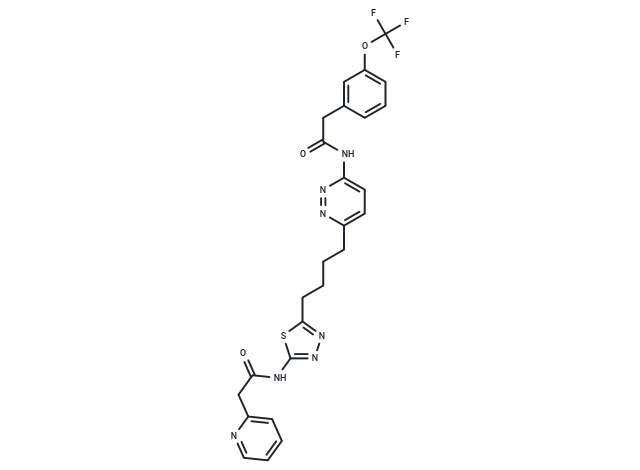Shopping Cart
- Remove All
 Your shopping cart is currently empty
Your shopping cart is currently empty

Telaglenastat (CB 839) (IC50 of 24 nM), an effective, specific, and oral inhibitor, which is bioavailable glutaminase, for recombinant human GAC.

| Pack Size | Price | Availability | Quantity |
|---|---|---|---|
| 2 mg | $32 | In Stock | |
| 5 mg | $47 | In Stock | |
| 10 mg | $72 | In Stock | |
| 25 mg | $128 | In Stock | |
| 50 mg | $222 | In Stock | |
| 100 mg | $369 | In Stock | |
| 500 mg | $869 | In Stock | |
| 1 g | $1,190 | In Stock | |
| 1 mL x 10 mM (in DMSO) | $59 | In Stock |
| Description | Telaglenastat (CB 839) (IC50 of 24 nM), an effective, specific, and oral inhibitor, which is bioavailable glutaminase, for recombinant human GAC. |
| Targets&IC50 | Glutaminase:24 nM |
| In vitro | CB-839 exhibits time-dependent and slowly reversible kinetics. IC50 values for glutaminase inhibition by CB-839 following preincubation with rHu-GAC for-1 hour are < 50 nmol/L, at least 13-fold lower than with BPTES. CB-839 has antiproliferative activity in a triple-negative breast cancer (TNBC) cell line, HCC-1806, while no antiproliferative activity is observed in an estrogen receptor–positive cell line, T47D.[1] |
| In vivo | In the mouse TNBC model, single agent CB-839 (200 mg/kg, p.o.) suppresses tumor growth by 61% relative to vehicle control. In the mouse JIMT-1 xenograft model, CB-839 alone (200 mg/kg, p.o.) results in 54% tumor growth inhibition (TGI) relative to vehicle control, combination of CB-839 (200 mg/kg, p.o.) with paclitaxel (10 mg/kg, p.o.) largely suppresses the regrowth of the tumors resulting in a TGI relative to vehicle control of 100%.[1] |
| Kinase Assay | Inhibition of CB-839 on rHu-GAC: The enzymatic activity is measured in assay buffer containing 50 mM Tris-Acetate pH 8.6, 150 mM K2HPO4 , 0.25 mM EDTA, 0.1 mg/mL bovine serum albumin, 1 mM DTT, 2 mM NADP+ and 0.01% Triton X-100. To measure inhibition, the inhibitor (prepared in DMSO) is first pre-mixed with glutamine and glutamate dehydrogenase (GDH) and reactions are initiated by the addition of rHu-GAC. Final reactions contains 2 nM rHu-GAC, 10 mM glutamine, 6 units/mL GDH and 2% DMSO. Generation of NADPH is monitored by fluorescence (Ex340/Em460 nm) every minute for 15 minutes on a SpectraMax M5e plate reader. Relative fluorescence units (RFU) are converted to units of NADPH concentration (μM) using a standard curve of NADPH. Each assay plate incorporates control reactions that monitores the conversion of glutamate (1 to 75 μM) plus NADP+ to α-ketoglutarate plus NADPH by GDH. Under these assay conditions, up to 75 μM glutamate is stoichiometrically converts to α-ketoglutarate/NADPH by GDH. Initial reaction velocities are calculated by fitting the first 5 minutes of each progress curve to a straight line. Inhibition curves are fitted to a four-parameter dose response equation of the form: % activity = Bottom + (Top-Bottom)/(1+10^((LogIC50-X)*HillSlope)). |
| Cell Research | For viability assays, all cell lines are treated with CB-839 at the indicated concentrations for 72 hours and analyzed for antiproliferative effects using Cell Titer Glo.(Only for Reference) |
| Alias | CB-839, CB839, CB 839 |
| Molecular Weight | 571.57 |
| Formula | C26H24F3N7O3S |
| Cas No. | 1439399-58-2 |
| Smiles | FC(F)(F)Oc1cccc(CC(=O)Nc2ccc(CCCCc3nnc(NC(=O)Cc4ccccn4)s3)nn2)c1 |
| Relative Density. | 1.430 g/cm3 (Predicted) |
| Storage | Powder: -20°C for 3 years | In solvent: -80°C for 1 year | Shipping with blue ice. | |||||||||||||||||||||||||||||||||||
| Solubility Information | H2O: < 1 mg/mL (insoluble or slightly soluble) Ethanol: < 1 mg/mL (insoluble or slightly soluble) DMSO: 60 mg/mL (104.97 mM), Sonication is recommended. | |||||||||||||||||||||||||||||||||||
| In Vivo Formulation | 10% DMSO+40% PEG300+5% Tween 80+45% Saline: 9.3 mg/mL (16.27 mM), Suspension. Please add the solvents sequentially, clarifying the solution as much as possible before adding the next one. Dissolve by heating and/or sonication if necessary. Working solution is recommended to be prepared and used immediately. The formulation provided above is for reference purposes only. In vivo formulations may vary and should be modified based on specific experimental conditions. | |||||||||||||||||||||||||||||||||||
Solution Preparation Table | ||||||||||||||||||||||||||||||||||||
DMSO
| ||||||||||||||||||||||||||||||||||||

Copyright © 2015-2025 TargetMol Chemicals Inc. All Rights Reserved.